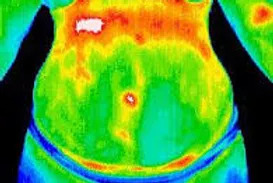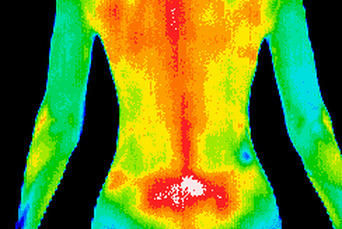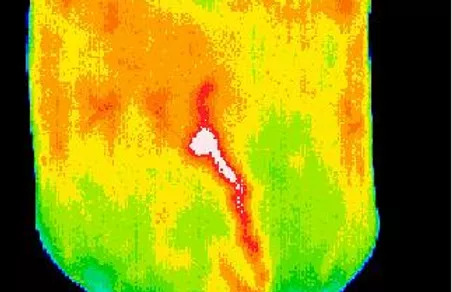
What is Abdominal Thermography?
Abdominal thermography is a specialized form of thermal imaging (also called “thermography”) that focuses on the abdominal region. Using a thermal-infrared camera it measures temperature variations across the surface of the abdomen and related structures. These temperature patterns may reflect underlying physiological and pathological processes — for example, increased blood flow, inflammation, organ dysfunction, or structural changes in the abdomen and lower back.
An abdominal series may indicate digestive disorders, organ dysfunction, colon inflammation, lower back pain, disc disease, and much more.


'Visualizing' lower back pain. Pain often radiates and is felt elsewhere from where it actually originates. Thermography can help identify the source of pain.
This thermogram shows the abdomen of a patient with hepatitis. The hepatic blood vessel (closed after birth) has now opened from the liver to the umbilicus.

Benefits of Abdominal Thermography
- Non-invasive & radiation-free: Unlike CT scans, X-rays or some other imaging modalities, thermography merely senses the heat radiation emitted by the body—no ionizing radiation involved.
- Quick & patient-friendly: A thermographic scan typically involves standing or lying in a prepared state, and capturing thermal images. It’s painless, doesn't require contrast agents, needles or incisions.
- Can detect subtle changes early: Because the method is sensitive to surface temperature changes, it may pick up early vascular/perfusion changes or inflammation before structural changes become obvious.
- Provides a visual map: The thermogram shows a thermal “map” of the region. For practitioners trained in interpretation, this can offer insight into patterns of dysfunction — not just isolated numbers.
- Complementary tool: It can serve as an adjunct to other diagnostic approaches (clinical exam, lab tests, imaging) rather than wholly replacing them. For example, if someone has vague abdominal/back pain, thermography may add data to guide further testing.
Why the Abdomen?
- The abdomen houses many organs (liver, stomach, intestines, pancreas), the abdominal wall, and is connected to the lower back via structural anatomy (vertebrae, discs, nerves). Thus many dysfunctions may manifest as changes in heat distribution.
- For example, if a disc disease in the lower back is causing referred pain or sympathetic changes, the overlying abdominal region may show subtle thermal anomalies.
- The Thermography Advantage website suggests: “Pain often radiates and is felt elsewhere from where it actually originates. Thermography can help identify the source of pain.”
What to Expect During an Abdominal Thermography Study
Here’s a practical overview of how a typical abdominal thermography session might be conducted:
-
Preparation
-
The patient may be asked to abstain from heavy exercise, caffeine, nicotine, or using hot/cold packs on the abdomen for a certain period before scan.
-
The ambient temperature in the imaging room is stabilized (to avoid external thermal influences).
-
The patient may be asked to expose the abdominal region, remove jewelry or heavy clothing, and remain still for a short period to acclimate.
-
-
Imaging
-
Thermal infrared camera captures images of the abdomen (frontal, perhaps lateral and lower/back if requested).
-
The technician ensures consistent positioning, focus, emissivity calibration, and standardized distance.
-
-
Image Processing & Interpretation
-
The captured thermogram shows thermal gradients (often color-coded from cooler to warmer).
-
A trained clinician or thermographer assesses symmetry (left vs right), hot spots, cold spots, patterns of heat spreading, etc.
-
Example: In the Thermography Advantage page, they mention an enlarged (opened) hepatic blood vessel visible as abnormal thermal pattern in a patient with hepatitis.
-
-
Report & Follow-Up
-
The report typically describes any abnormal thermal patterns. It may suggest correlation with the patient’s symptoms (e.g., abdominal pain, digestive issues, back pain) and recommend further evaluation (lab tests, imaging, specialist referral) if warranted.
-
Because thermography is a snapshot in time, the clinician may recommend follow-up scans to monitor changes (e.g., improvement with treatment, worsening of condition).
-